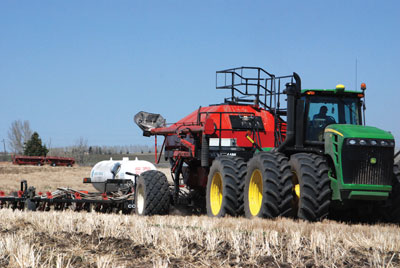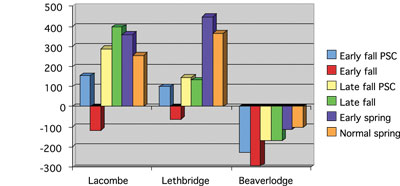
News
Early spring seeding canola more profitable and less risky
Economic and risk analysis re-search of canola seeding dates supports the adoption of early spring seeding of canola.
February 24, 2009 By Top Crop Manager
Economic and risk analysis re-search of canola seeding dates supports the adoption of early spring seeding of canola. Data from a multi-year AAFC field experiment conducted at three locations in Alberta were used to investigate the effect of canola cultivar, time of seeding and polymer seed coating (PSC) on profitability and risk.
 |
|
| Early spring seeding is the least risk and most profitable. Photo by Bruce Barker |
Scientists at Agriculture and Agri-Food Canada (AAFC) conducted the research and risk analysis.The trials used a hybrid (InVigor 2153) and open pollinated (Exceed) cultivar seeded at early and late fall, and early and normal spring seeding dates. Fall seeding dates also included a PSC treatment. Field experiments were conducted at Lacombe, AB (1999–2001), Beaverlodge, AB (1999–2001) and Lethbridge, AB (2000–2001). Profitability was measured as return to land and labour, using canola and input prices averaged during the years of the study.
Spring seeding more profitable
Canola seeded in early or normal spring was more profitable and risk efficient compared with dormant seeding in early or late fall, however the results varied across site. For example, early spring seeding at Lethbridge was the most profitable timing for both InVigor and Exceed. At Lacombe, early spring and late fall without PSC were the most profitable, and these yields were higher than any Exceed treatment. At Beaverlodge, the mean net returns were negative in all cases, which was due to limited precipitation and low yields (Exceed seed at normal spring date had the highest profitability partially due to lower input costs). Of note across all locations, is that early seeded mean profitability for each cultivar was always the significantly highest profitable treatment.
| Graph 1. The mean net returns of InVigor canola due to seeding decisions at three locations | |

|
|
| Note: $/ac = $/ha divided by 2.47.Source: Upadhyay, B. M., Smith, E. G., Clayton, G. W., Harker, K. N., O’Donovan, J. T. and Blackshaw, R. E. 2005. Economic evaluation of seeding decisions in hybrid and open-pollinated herbicide-resistant canola (Brassica napus). Can. J. Plant Sci. 85:761–769. |
The economic benefit of PSC was more pronounced with early than late fall dormant seeding. However, despite the use of PSC for the early fall seeding increasing profitability, profitability still was not competitive with spring seeding. Lower risk with early spring seedingDespite occasional superior performance of late fall seeding, spring seeding was generally preferred to fall seeding from a risk perspective. Early spring seeding dominated normal spring seeding dates from a lower risk perspective, with an exception at Beaverlodge, where normal seeding with Exceed had the lowest loss and risk. Overall, the most profitable seeding date was also the least risky, so risk seldom affected the best seeding decision.
Dormant seeded canola in early fall did not have an acceptable risk or a reduction in risk. Late fall dormant seeding with PSC usually did not have an acceptable risk.
The seeding date treatments also were analyzed for price sensitivity. Using the average canola price as the standard index, the researchers found that the most profitable seeding decisions at average prices were generally the most profitable over a broad price range. Spring seeding had the lowest likelihood of a loss, and the highest likelihood of a profit, compared to the analyzed price range. For canola producers, the results show that seeding canola as early as possible in the spring generally provides the greatest profitability and lowest risk over a wide range of prices. Fall seeding canola, for the most part, is riskier and less profitable than spring seeding, whether PSC technology is used or not.
Reprinted with permission from the Alberta Canola Producers
Commission. The research was supported by the Alberta Canola Producers
Commission, Agriculture and Agri-Food Canada, Alberta Crop Industry
Development Fund and the Canola Check-off Fund.